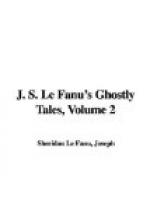I have nothing to add, for very soon after this my physician pronounced a longer stay unnecessary for my health, and we took our departure for another place of abode. I may add, that although I have resided for considerable periods in many other houses, I never experienced any annoyances of a similar kind elsewhere; neither have I made (stupid dog! you will say), any inquiries respecting either the antecedents or subsequent history of the house in which we made so disturbed a sojourn. I was content with what I knew, and have here related as clearly as I could, and I think it a very pretty puzzle as it stands.
[Thus ends the statement, which we abandon to the ingenuity of our readers, having ourselves no satisfactory explanation to suggest; and simply repeating the assurance with which we prefaced it, namely, that we can vouch for the perfect good faith and the accuracy of the narrator.—E.D.U.M.]
Ultor De Lacy: A Legend of Cappercullen
CHAPTER I
The Jacobite’s Legacy
In my youth I heard a great many Irish family traditions, more or less of a supernatural character, some of them very peculiar, and all, to a child at least, highly interesting. One of these I will now relate, though the translation to cold type from oral narrative, with all the aids of animated human voice and countenance, and the appropriate mise-en-scene of the old-fashioned parlour fireside and its listening circle of excited faces, and, outside, the wintry blast and the moan of leafless boughs, with the occasional rattle of the clumsy old window-frame behind shutter and curtain, as the blast swept by, is at best a trying one.
About midway up the romantic glen of Cappercullen, near the point where the counties of Limerick, Clare, and Tipperary converge, upon the then sequestered and forest-bound range of the Slieve-Felim hills, there stood, in the reigns of the two earliest Georges, the picturesque and massive remains of one of the finest of the Anglo-Irish castles of Munster—perhaps of Ireland.
It crowned the precipitous edge of the wooded glen, itself half-buried among the wild forest that covered that long and solitary range. There was no human habitation within a circle of many miles, except the half-dozen hovels and the small thatched chapel composing the little village of Murroa, which lay at the foot of the glen among the straggling skirts of the noble forest.
Its remoteness and difficulty of access saved it from demolition. It was worth nobody’s while to pull down and remove the ponderous and clumsy oak, much less the masonry or flagged roofing of the pile. Whatever would pay the cost of removal had been long since carried away. The rest was abandoned to time—the destroyer.
The hereditary owners of this noble building and of a wide territory in the contiguous counties I have named, were English—the De Lacys—long naturalized in Ireland. They had acquired at least this portion of their estate in the reign of Henry VIII, and held it, with some vicissitudes, down to the establishment of the revolution in Ireland, when they suffered attainder, and, like other great families of that period, underwent a final eclipse.




